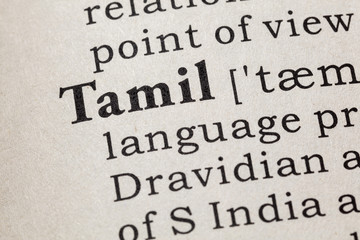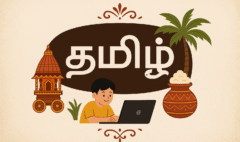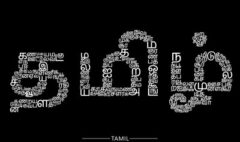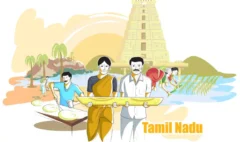An Introduction to Tamilian Traditional Dress
An Introduction to Tamilian Traditional Dress
An Introduction to Tamilian Traditional Dress
Every culture tells a story, and often, that story is woven into the very fabric of its clothing. For the Tamil people, traditional dress is more than just a matter of style; it is a profound expression of heritage, history, and identity. From the flowing elegance of a silk saree to the simple dignity of a veshti, traditional Tamil dress is a beautiful and meaningful art form. This guide will introduce you to the key garments and the rich vocabulary that surrounds them, providing you with a deeper understanding of Tamil culture and its aesthetic values.
By learning the names of these traditional garments, you are not just expanding your vocabulary; you are gaining a window into a culture that values modesty, craftsmanship, and tradition. We will explore the key pieces of Tamil attire, the fabrics used, and how they are worn for different occasions, giving you a glimpse into the vibrant `fashion in Tamil Nadu`.
The Fabric of Culture: What is Traditional Tamil Dress?
The core of traditional Tamil attire is rooted in simplicity, comfort, and the use of natural fibers that are suited to the hot climate. The clothing is designed to be both functional and elegant, and it is a key part of the culture’s visual identity. The two most iconic garments are the saree for women and the veshti for men, both of which have been worn for centuries and are still a common sight today.
Essential Cultural Clothing Vocabulary
Here are the names of the most important pieces of Tamil attire and the fabrics used to make them. This is the key `cultural clothing vocabulary` you need to understand and talk about traditional Tamil dress.
For Women
- சேலை (Saree): The saree is the most iconic piece of traditional Indian clothing. It is a long, unstitched cloth that is draped around the body in a variety of styles. Tamil sarees are particularly known for their vibrant colors and rich silk.
- பட்டு (Pattu): Silk. Tamil Nadu is famous for its high-quality silk, especially from Kanchipuram. A silk saree is a sign of elegance and is worn for all major celebrations, especially weddings.
- பாவாடை தாவணி (Pavadai Dhavani): This is the traditional half-saree worn by young girls and teenagers. It consists of a full skirt (Pavadai), a blouse, and a long shawl (Dhavani) that is draped over the body. It is a beautiful garment that is a common sight in villages and for family celebrations.
- சட்டை (Sattai): Blouse. The blouse is a short-sleeved top worn under the saree.
- சல்வார் கமீஸ் (Salwar Kameez): While not traditionally Tamil, the salwar kameez is a very popular form of attire among modern Tamil women. It consists of a long tunic (Kameez), trousers (Salwar), and a scarf (Dupatta). It is a comfortable and practical choice for everyday wear.
For Men
- வேஷ்டி (Veshti): The veshti is the most iconic piece of men’s `Tamil attire`. It is a long, unstitched piece of white or cream-colored cotton or silk cloth that is wrapped around the waist and legs. It is a comfortable and dignified garment worn for both formal and informal occasions.
- துண்டு (Thundu): A small piece of cloth or towel that is draped over the shoulder. It is an essential part of a man’s attire and is used for a variety of practical purposes.
- சட்டை (Sattai): Shirt. The shirt is worn with the veshti and can be either a traditional full-sleeved shirt or a simple cotton shirt.
Dress for Every Occasion
The choice of `traditional Tamil dress` often depends on the occasion. For a wedding, women will wear a rich silk saree with intricate gold patterns, while men will wear a silk veshti with a matching silk shirt. For a festival like Pongal, families will wear new clothes in vibrant, happy colors. For everyday wear, a simple cotton saree or a cotton veshti is a comfortable and practical choice. This variation in attire for different occasions is a key part of the cultural expression in Tamil Nadu.
The Role of Fashion in Tamil Nadu Today
While traditional dress remains deeply valued, `fashion in Tamil Nadu` has also evolved. Young people today often blend traditional and modern styles, wearing jeans with a kurta or pairing a silk pavadai with a modern top. This fusion of styles is a testament to the fact that Tamil culture is a living, breathing thing that is constantly adapting and evolving while still holding on to its core identity. The saree, in particular, has seen a modern resurgence, with young designers creating new and innovative ways to drape and style it.
Learning Through Dress
Talking about clothes is a fantastic way to practice your Tamil. You can use this vocabulary to describe what you are wearing, ask a friend what they are wearing, or talk about the different colors and fabrics. For example, “Enakku pattu pudikkum” (I like silk) or “Indha saree alaga irukkirathu” (This saree is beautiful). This type of `conversational Tamil` is both practical and a fun way to improve your skills.
Conclusion
Traditional Tamil dress is a beautiful and meaningful art form that tells a story of history, identity, and tradition. By learning the names of these garments and the context in which they are worn, you are not just expanding your vocabulary; you are gaining a deeper appreciation for the culture. This knowledge will help you feel more connected to the Tamil people and their heritage, whether you are at a wedding, a festival, or just in a simple conversation.
At Powerkid Tamil, our expert tutors can help you master this `cultural clothing vocabulary` and more. Our personalized lessons are designed to go beyond the textbook, providing you with a holistic understanding of the language and its culture. Start your lesson today and unlock a new level of cultural connection through the art of Tamil attire.










